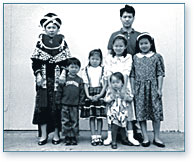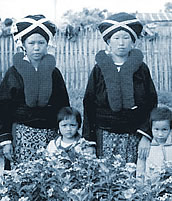 The Hmong (or Mong) and Iu-Mien (or Mien), two ethnic groups that fled to escape persecution in Laos, have been studied extensively because of the stark adjustments they were forced to make as refugees. Both are hill tribes from the highlands of Laos; some are from Vietnam and Cambodia (as well as from countries in Southeast Asia such as Burma and Thailand), and their ancestry can be traced back to 2000 B.C. in China. The Hmong originated in southwestern China and, as a result of Chinese expansionism and persecution, the Hmong (called Miao by the Chinese) were forced to migrate to Southeast Asia. The Hmong (or Mong) and Iu-Mien (or Mien), two ethnic groups that fled to escape persecution in Laos, have been studied extensively because of the stark adjustments they were forced to make as refugees. Both are hill tribes from the highlands of Laos; some are from Vietnam and Cambodia (as well as from countries in Southeast Asia such as Burma and Thailand), and their ancestry can be traced back to 2000 B.C. in China. The Hmong originated in southwestern China and, as a result of Chinese expansionism and persecution, the Hmong (called Miao by the Chinese) were forced to migrate to Southeast Asia.
The majority of Hmong and Iu-Mien in the U.S. come from Laos. The Iu-Mien (also called Yao) migrated in the 19 th century, surviving as subsistence farmers in remote mountainous areas. They participated in “slash-and-burn” agriculture, which involved moving to new land every decade, growing vegetables and opium poppies as cash crops.
Ethnic groups from Laos fought during the Indochinese Wars in covert military operations, first on the side of the French and later the Americans. The U.S. Central Intelligence Agency (CIA) and U.S. military recruited ethnic groups from Laos to break up the clandestine “Ho Chi Minh Trail” that sustained the Viet Cong and the North Vietnamese Army in South Vietnam. Laotians were also recruited to provide intelligence information and surveillance in this “secret war.” With the assistance of the Hmong leader General Vang Pao, boys and men were enlisted from remote villages. They were valued because of their familiarity with the jungle terrain and their reputation as fierce fighters, which had been proven in their insurrections against the French colonial administration. In exchange for their sacrifices, they were promised that their families would be cared for, and they hoped that a regime change would bring them autonomy and protect their territory.
Continued on page 2 |
<< Back |
[1] 2 |
Next >> |
|


 The Hmong (or Mong) and Iu-Mien (or Mien), two ethnic groups that fled to escape persecution in Laos, have been studied extensively because of the stark adjustments they were forced to make as refugees. Both are hill tribes from the highlands of Laos; some are from Vietnam and Cambodia (as well as from countries in Southeast Asia such as Burma and Thailand), and their ancestry can be traced back to 2000 B.C. in China. The Hmong originated in southwestern China and, as a result of Chinese expansionism and persecution, the Hmong (called Miao by the Chinese) were forced to migrate to Southeast Asia.
The Hmong (or Mong) and Iu-Mien (or Mien), two ethnic groups that fled to escape persecution in Laos, have been studied extensively because of the stark adjustments they were forced to make as refugees. Both are hill tribes from the highlands of Laos; some are from Vietnam and Cambodia (as well as from countries in Southeast Asia such as Burma and Thailand), and their ancestry can be traced back to 2000 B.C. in China. The Hmong originated in southwestern China and, as a result of Chinese expansionism and persecution, the Hmong (called Miao by the Chinese) were forced to migrate to Southeast Asia.